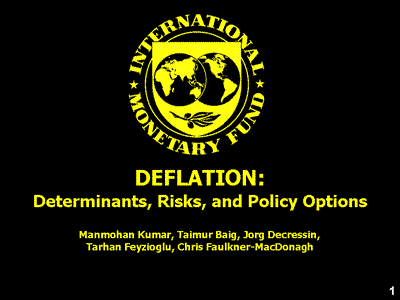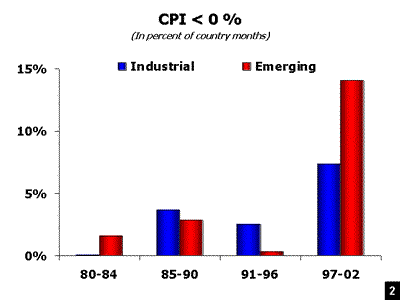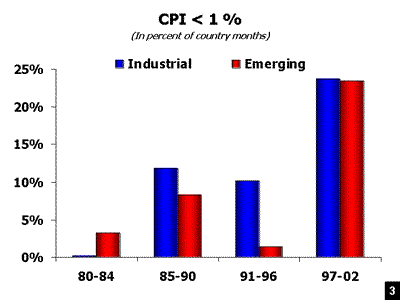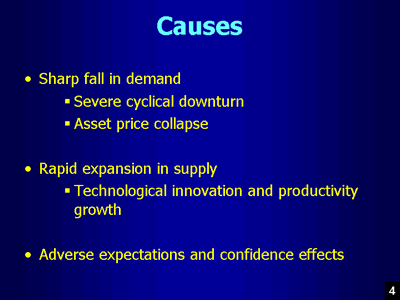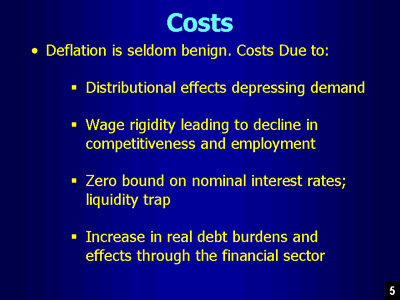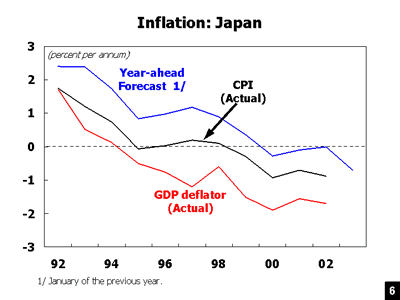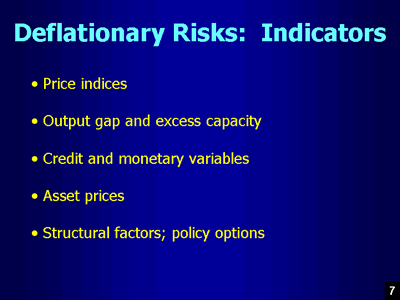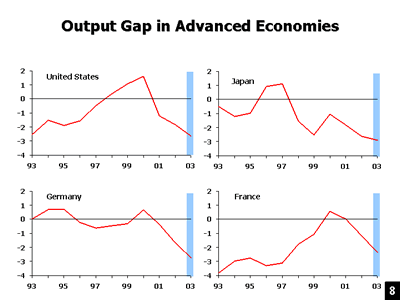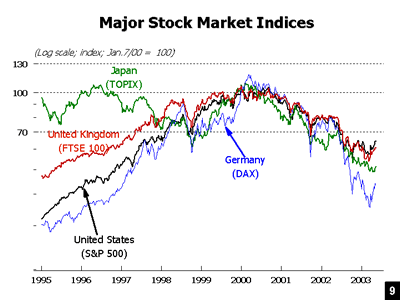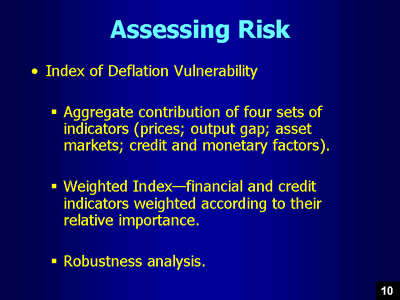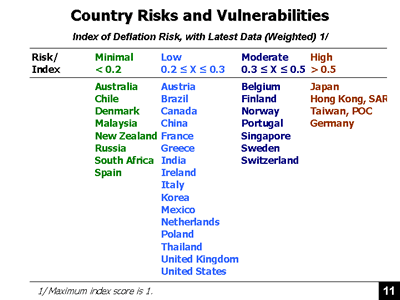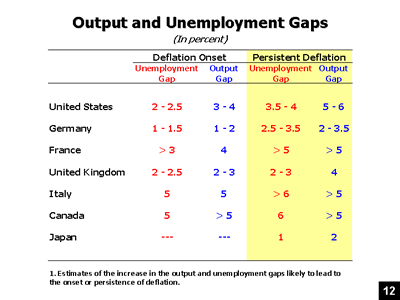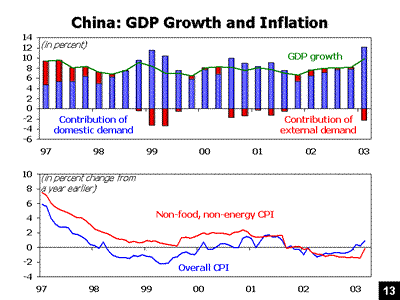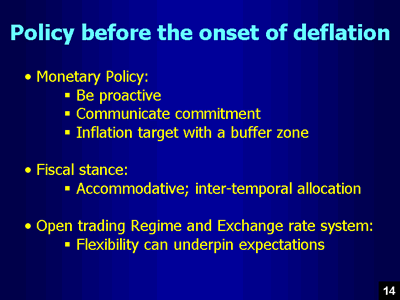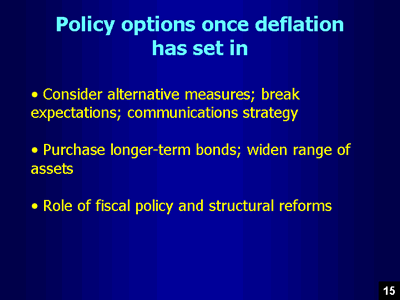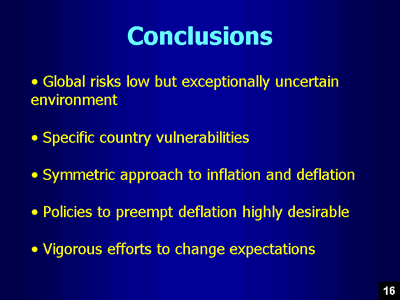Transcript of an IMF Economic Forum: Should We Be Worried About 'Deflation'?
May 29, 2003
Washington DC, May 29, 2003
(View this Economic Forum using Windows Media Player.)
Participants:
Kenneth Rogoff (Moderator), Economic Counselor and Director of the Research Department, IMF
Manmohan S. Kumar, Advisor, Research Department, IMF
Laurence Ball, Professor of Economics, Department of Economics, Johns Hopkins University
Vincent Reinhart, Director of Monetary Affairs, Board of Governors, U.S. Federal Reserve System
Kim Schoenholtz, Chief Economist, Citigroup Global Markets
|
MR. STARRELS: Well, welcome to another IMF Economic Forum. I'm delighted to see you here today. This is a precedent-setting exercise of sorts. We've actually had two such events this week, and both of them are being chaired by Kenneth Rogoff, the Fund's Economic Counselor and Director of the IMF's Research Department. Ken, the floor is yours. MR. ROGOFF: Thank you very much, John, and thank you to the audience. The title of this economic forum is "Should We Be Worried About Deflation?" John chose it. We are worried about deflation. The IMF just released a report, which Manmohan Kumar, one of the panelists, is going to talk about called, "Deflation: Determinants, Risks and Policy Options." Of course, one of the findings of the report is that although the risks of global deflation are relatively low, we see risks of deflation intensifying in Japan, and we see risk, significant risk, of mild deflation in Germany. We have four panelists today. I've already mentioned Manmohan Kumar, who will be speaking first. I might add that Manmohan, in addition to being the lead author on the IMF paper, also has a piece coming out in Finance and Development in the next week or so, which will actually have several articles about deflation. Our other speakers are Laurence Ball, who is a Professor of Economics at Johns Hopkins, and I might add a former colleague of mine from Princeton University. We have Vince Reinhart, who is famous to all of you at the fund as husband of Carmen Reinhart, the shining light of the Research Department at the IMF. [Laughter.] MR. ROGOFF: But in addition to that, he is also the Secretary and Economist to the Federal Open Market Committee, and although he doesn't write it on his vita this way, I would say Alan Greenspan's right-hand man. And, finally, Kim Schoenholtz, who is Chief Economist and Managing Director of Citigroup Global Markets. Just one or two other words before I start. The paper that was released just over a week ago was written by a task force that I set in November [2002] in conjunction with three other departments—APD, EU1, and Western Hem. I supervised the task force, but Manmohan, who will speak today, is the lead author, and it's a very broad-ranging report. It looks at the history of deflation, it looks at policy issues, what do you do if you see a risk of getting into deflation, what do you do if you're in deflation. It's very comprehensive. I say that because, Manmohan, we're only giving you 10 minutes, and he can answer questions afterwards. I might mention that, in preparing for this Forum, the task force has updated the report, some of the data in the report, and find that the rankings and conclusions actually all still stand and, in particular, what I said about there being significant risk of mild deflation in Germany and risk that deflation in Japan will intensify. With that, let me turn the floor over to Manmohan. MR. KUMAR: Thanks very much, Ken.
As you indicated, the staff study issued earlier reports the findings of an interdepartmental task force, which included Taimur Baig, Jorg Decressin, Chris Falkner-MacDonagh and Tarhan Feyzioglu. The main motivation of the study was the recent increase in concerns about deflation, which have risen against a background of falling inflation rates, massive declines in global equity markets, widening output gaps, as well as geopolitical uncertainties. The fall in price pressures is quite striking. This chart shows the share of industrial and large emerging market economies experiencing episodes of declining prices in terms of country months relative to total. This share has increased from around 1 to 3 percent in the first half of the 1990s to 8 to 15 percent in the past 5 years. So you see this share, in terms of country months relative to total, where prices were actually declining in industrial countries going from around 3 percent or so to around 8 percent in the second half of the last decade.
Given the upward bias in measured inflation due to inadequate reflection of substitution possibilities or new products, measured inflation of less than 1 percent may already be close to price stability or even reflect declining prices. Given that, mild deflation may be affecting an even higher proportion of countries, as shown in this chart. So this chart shows country months relative to total, where inflation was less than 1 percent, and the point is that, given the bias, even this may be reflecting a period of price stability or declining prices.
Deflation can be caused by both demand and supply factors. Sharp falls in demand, reflecting a severe cyclical downturn, the bursting of an asset price bubble or excessively tight policies can result in declining activity and prices. The alternative is a large supply shock that results in higher output, even while prices may be declining. This can reflect a variety of factors, including technological innovation and productivity growth. Once prices start declining, expectations play a crucial role. Weakness in activity may be followed by increasing downward pressures on prices, reinforcing expectations about price declines in the future.
Deflation may not entail significant costs if it reflects temporary factors, say, declining import prices, or an expansion in aggregate supply. However, sustained deflation is seldom benign. It leads to a redistribution of income from debtors to creditors, depressing demand. Given inflexible wages, real wage costs rise, leading to declining profits and employment. With the natural flow of zero nominal interest rates, the effectiveness of monetary policy is curtailed. This is of particular concern when output is weakening. And credit intermediation can be severely distorted as collateral loses value. The biggest concern, of course, is that a temporary period of declining prices develops into a sustained and self-enforcing deflationary spiral. These effects are apparent from an assessment of historical episodes of deflation. The most extreme case was the worldwide deflation and the catastrophic collapse in activity in the late 1920s and early 1930s. But even the milder deflationary episodes of the 19th century are not benign. Deflation was generally associated with rising debt burdens and bankruptcies, social and political unrest, financial crises and significant output volatility. More recently, the deflation in Japan has been associated with sub par performance over several years. The historical episodes of deflation also highlight the fact that deflation is difficult to anticipate. This is illustrated by the recent experience of Japan, also. As this chart shows, forecasts of inflation overestimated the likely outcome, even as deflation was setting in. So if you look in '97, forecasts made a year earlier were expecting inflation to be around 1 percent. The actual outcome was a decline in GDP deflation of 1 percent and near stability on the CPI.
The paper develops a framework for estimating deflation risks across countries, using current and forward-looking variables. A range of indicators were identified as determining vulnerabilities, including, in addition to the price variables, measures of excess capacity or output gap, credit and monetary indicators and asset market conditions. Structural factors and policy flexibility also play a role in the overall assessment.
The paper discusses the evolution of these indicators and the channels of transmission. For illustration, this next chart shows the output gaps in four of the largest economies. You see that there are quite substantial output gaps which had been increasing.
The latest WEO (World Economic Outlook) projection suggests that the output gaps in these, as well as other industrial and emerging market economies, are likely to widen in the near term to levels that could exacerbate the downward pressure on prices. This next chart illustrates the very large declines in equity markets in the major industrial countries which has had significant adverse impact on activity and household and corporate balance sheets.
We estimated the likely contribution of each set of indicators to deflation risks. So, looking at prices, output gap, asset markets, credit and monetary factors, these estimates were aggregated to obtain an overall index of deflation vulnerability from the early 1990s to the present. An index, weighting the financial and credit indicators according to their relative importance in the economy, was also computed.
The results suggest that there has been an increase in the vulnerability to deflation for a number of industrial and emerging market economies. However, at this juncture, apart from the countries already beset with deflation, only a few additional countries appear to have heightened vulnerability: Japan at the top of the list, followed by Hong Kong SAR, and Taiwan Province of China, where all three already have deflation.
The score for the United States indicates a low risk. In Europe, risks of mild deflation also appear low in all major countries except Germany, where the higher vulnerabilities reflect weak demand and credit growth and financial sector strains in the context of limited room for policy maneuver. Part of the downward price pressures there have reflected adjustment as a member of the Monetary Union, and this may also provide a floor for price expectations and activity, helping forestall sustained deflation. For the G-7 economies, the indicators analysis was supplemented by estimating the Phillips Curve relationships of the changes required in the output and the unemployment gap to set off or exacerbate deflation. These yielded results consistent with the indicators analysis. So this table shows that, according to these estimates, in the United States, the unemployment gap would have to increase by 2 percentage points or more for there to be onset of mild deflation; in Germany, 1 to 1.5 percentage points. Japan, of course, already has deflation, and here the unemployment gap would have to increase by 1 percentage point for deflation to get worse, as defined as an increase in deflation of 2 percentage points.
We also examined the determinants of deflation in China. It was seen to be mostly linked to transitory, as well as longer-term supply-related factors. Given the strong pace of activity, GDP growth has averaged about 7 percent for several years.
Deflationary pressures are expected to continue to ease as transitory effects fade. However, some longer-term factors, including expansion in capacity and excess labor, could continue to weigh in on prices. We did not see any compelling evidence of international transmission of deflation, although price pressures in individual sectors are becoming acute. Given the downside risks in specific economies, and given the costs of deflation, the paper emphasizes that it is desirable to prevent it from taking root, rather than deal with it once it has become entrenched. Preventing deflation in a low-inflation environment requires preemptive action. A clear communication strategy, highlighting the ability and commitment of policymakers to contain deflation is important. This is particularly necessary if financial institutions come under stress, say, following the bursting of an asset price bubble.
The monetary policy regime can play an important role. For instance, a regime with an explicit inflation target should aim for an adequate buffer zone to reduce the risk of inflation falling so close to zero that the economy becomes susceptible to deflation. Fiscal policy, tailored to credibly boost aggregate demand, can also play an important role. An open trading system offers a measure of protection from deflation, although this protection is much greater under flexible, rather than fixed exchange rates. Dealing with deflation when it has set in is more difficult because the traditional relationships between policy and economic variables may be altered. In these circumstances, a credible commitment to end deflation is even more crucial. There are a variety of monetary policy measures which can be used, including lowering long-term rates by purchasing bonds and widening the range by purchasing equities or foreign currency-denominated assets.
Fiscal measures can also play an important role. The unconventional monetary measures can pose operational challenges because their impact may be uncertain, but these uncertainties and any risks are likely to be small compared to the costs associated with entrenched and deepening deflationary expectations. In sum, while risks of generalized global deflation appear small, there is an increased vulnerability to deflation in several countries. The main policy message is that a more symmetric attention to risks of falling, as well as rising, prices is warranted. Given the costs of deflation, it is desirable to prevent it from setting in. Where it has taken hold, aggressive policies to contain and eradicate deflationary expectations are essential.
Thanks very much. MR. ROGOFF: Thank you very much. Our next speaker is Laurence Ball, who, by the way, was on National Public Radio last night, but he had already agreed to speak here before he knew that his speaking fees were going to be inflated. [Laughter.] MR. ROGOFF: Thank you, Larry. MR. BALL: Thank you. I have a two-page handout. If you didn't get it already, it's outside. My first comment is simply that I like this IMF paper quite a bit. I think it's very well done and very balanced, and I agree with most of it. I'll try to be somewhat interesting, nonetheless. Most of my comments, since I agree with the thrust of it, most of my comments will be quibbling around the edges and then just amplifying some points that I agree with. I think the main quibble I would make, or the one way in which I would have written the paper differently, is I would put the underlying problem a little bit differently. In my view, the primary danger or the thing to worry about is not deflation per se. I doubt that there's anything really terrible about the price level, say, falling steadily by 1 or 2 percent a year. I think what we should worry about is, rather, the liquidity trap, which I would define as a combination of a large output gap, which calls for a monetary stimulus, along with a zero interest rate, which prevents a monetary stimulus, at least of the conventional sort. Now, my reason for that belief is I think history has shown us that in the U.S. and in most developed countries, when recessions occur, interest rate reductions are the main way that they end. I reference I think a wonderful paper by Romer & Romer called, "What Ends Recessions?" And the answer is the Fed ends recessions by cutting interest rates, and that's a very strong historical pattern. If interest rates are zero, that means, of course, they can't be cut any more, and we lose the usual tool for dealing with whatever adverse shocks affect the economy. I think history also shows us that the self-correcting forces in economies are not terribly strong, and so if we lack the usual policy tools, there's a substantial risk that an adverse shock could lead not just to a temporary downturn, but to long-term stagnation, and of course Japan, in the last decade or more, is the clear example of that. But again, the point I want to make is that interest rates are the key thing to think about. Therefore, I think some of the discussion of the price level, is the price level really negative or is it slightly positive, what's the chance that it'll get all of the way to zero, should we look at the CPI or the PPI, I think a lot of those issues are a little bit aside from the point. I think the key point really has to do with the output gap and the interest rate. The output gap tells you how much monetary stimulus the economy needs, and the interest rate tells you how much is available. And so if you do the calculations, for example, and decide, well, gee, this economy needs a 2-percent rate reduction, and rates are currently 1 percent, that's when you know that you have a problem. Now, as far as applying this to different countries, again, I largely will echo what the paper says. Japan is clearly already in a liquidity trap. I think actually the language of the paper struck me as a little funny. Talking about the risk of liquidity trap in Japan is kind of like talking about a person's mortality risk if he's dead. [Laughter.] MR. BALL: Japan is already there. Now, Germany, I think a real contribution of the paper is highlighting the risks in Germany, which some people have tried to downplay or pooh-pooh, but I agree with the paper that there's real cause for concern about Germany. Germany is currently into its third year of growth well below 1 percent. So if somebody is rooting for a decade of stagnation, we have a good start on that, with 2 going on 3 years. Again, I don't see any self-correcting forces that are necessarily going to make the economy turn around sharply all by itself. Clearly, what Germany needs is a monetary easing, and they can't do that. Now, of course, the problem here is not the fact that interest rates are zero bound, the problem is that there isn't a German interest rate that the German Central Bank controls, but it amounts to the same thing; that we don't have the usual interest rate tool to apply to Germany. What makes Germany even more worrisome, of course, is the fact that the usual back-up parachute or what you do if, for some reason, you lose monetary policy is, well, you always have a fiscal policy. But in Germany, because of the Stability and Growth Pact—I wrote the name in reverse on the handout—because of the Stability and Growth Pact, of course, fiscal policy is severely constrained. So there's, indeed, a lot of reason for concern about Germany. I further agree with the paper that there is less reason for concern about the United States. I think the most likely scenario for the U.S. is that everything will be just okay, just fine. We've had a mild recession. We're now recovering. I think the most likely or median outcome will be that we recover nicely and interest rates never get down all the way to zero, and this topic will start fading from memory in the U.S. On the other hand, it makes sense to be a little bit worried because, with the interest rate at 1.25 percent, there isn't a lot of room for error or ability to deal with some unforeseen shock. So, clearly, with the interest rate at 1.25 percent, the Fed does not currently have the ability to make a major expansion of monetary policy. Now, probably that won't be necessary because the economy is recovering, but of course we never know what might happen down the road, and it's a little bit worrisome that our usual insurance against recessions isn't so strong. Now, here, I'm really following along with Manmohan's talk. The obvious policy issues are, number one, how do you avoid a liquidity trap and, number two, if you do fall into one, how do you escape it? Now, Manmohan talked about several different ideas about how to avoid a liquidity trap. I want to highlight one of them which, in my view, is particularly simple and particularly likely to be effective, which is simply to make sure that if you're targeting inflation, explicitly or implicitly, you don't target too low a level, that you have a reasonably high inflation target. To try to make that specific, I would say that the consideration about liquidity traps suggests that the ECB's target, which let's say is 1 percent, if we interpret below 2 percent is around 1 percent, that's too low. The Bank of England is probably being more sensible in targeting 2.5 percent and, who knows, maybe the ideal target is even a little bit more than 2.5 percent. Why is that? Well, on the one hand, having a target of 2 or 3 or 4 percent, rather than 1 percent, greatly reduces the chance that you will hit the zero interest rate bound and find yourself in a liquidity trap, and the paper documents that nicely with some simulations. The basic idea, of course, being that a higher inflation target means that the normal level of nominal interest rates is higher, so you have more room to cut interest rates in an emergency. Furthermore, if the inflation target were raised to 3 or 4 percent, say, in Europe, in my opinion, there's really absolutely no evidence that that level of inflation has any economic cost we need to worry about. To the extent that studies will be able to tease out efficiency losses or adverse effects on growth from inflation, they set in at inflation rates well above 3 or 4 percent. Certainly, there's nothing to fear from inflation of 3 or 4 percent, which is nowhere of the magnitude of the dangers we're talking about when we talk about liquidity traps and deflation. So, of course, the best cure for deflation is not to get there in the first place. Suppose we do have a liquidity trap. Now, here, I'm a little bit less optimistic than the paper is, and some observers are, about the idea that, well, even if interest rates hit zero, central banks have lots of other tools with which they can stimulate the economy. They can buy tons of government bonds, they can intervene in foreign exchange markets, they can do this and that. I think, basically, these are speculative and unproven mechanisms. My guess, which is probably as good as anybody else's guess, is that these things wouldn't be too effective, unless they were carried out on a really massive scale, and you just bought huge amounts of foreign exchange or bonds, but then I think those huge operations could raise other kinds of problems that are hard to calibrate. Certainly, we learned from Japan that simply pursuing fairly aggressive open-market operations and expanding the monetary base at 30 or 40 percent a year is not enough to lift the economy out of a liquidity trap. So I think, in the end, we have to go back to wiser people than ourselves and say, well, what did Keynes say about liquidity traps? He said, well, if the LM curve is flat, you need to shift the IS curve through fiscal policy, and that strikes me as the most straightforward way to try to deal with what happens if you do get caught in a trap. Now, having said that, that fiscal policy is the right cure, that gives us further reason to worry about both Germany and Japan because both those countries have fiscal policy which is rather constrained; Germany, because of the Stability and Growth Pact, as I mentioned before, and Japan, because they have such a problem of a large and growing debt, that they're appropriately very reluctant to do anything which would further worsen the fiscal situation. So we can talk about different things Japan can do, but I think in the case of both Germany and Japan, the problem is there's really no easy answer. Once again, I think we can be more optimistic about the U.S. because even though the fiscal situation, the long-term fiscal situation in the U.S. is not great, it's nowhere near the disaster that the situation is in Japan. And so I think if we did find ourselves in dire straits, the U.S. has more room, more leeway for a fiscal expansion. So, overall, I think, at least relative to places like Germany and Japan, things look relatively rosy for the U.S., both because the U.S. is less likely to fall into a liquidity trap and also because, if we do, there are more straight forward tools that we can use to escape it. Thanks. MR. ROGOFF: Thank you very much. Our next speaker is Vince Reinhart, and while you're walking to the podium, Vince, I'll ask you if in your comments you're going to agree with the paper's conclusion that the U.S. belongs in the low risk of deflation category, but not necessarily the minimal risk category, and also our paper's interest rate policy advice to a country knocking at the door of sustained deflation, which I would characterize as "use it or lose it." [See a pdf file of Mr. Reinhart's slides (587 kb pdf file)] MR. REINHART: Thank you, Ken. Of course, you know I won't answer that question, but it was nice of you to ask. [Laughter.] MR. REINHART: For anyone following central banks over the years, the idea that inflation could get too low may seem jarring, but there are costs, as Manmohan mentioned. As shown in Exhibit 1, first, low inflation limits the extent of monetary policy stimulus, in that a given nominal funds rate translates to a higher real federal funds rate when inflation is low. Second, workers may resist a decline in wages in nominal terms; that is, a decline in real wages engineered by increases in prices with money wages unchanged or even rising may entail a lower psychic cost than an equivalent cut in money wages when prices are unchanged. Third, if a decline in inflation is unanticipated, borrowers will find that the real value of their obligations is greater than they originally anticipated. While there are winners, too, distributional effects may not wash out, raising the possibility of adverse effects on spending. This is one of those areas, though, where the rising tide of productivity growth raises all boats, as discussed in Exhibit 2. A quick increase in output per hour raises the real return to capital, making it less likely that the real interest rate has to become negative in order to spur the growth of aggregate demand. A more rapid expansion of output per hour also raises the growth of real wages, making it less likely that nominal wages have to fall. And faster productivity growth raises real incomes over time, making debt burdens more sustainable. This general discussion raises the possibility that the rate of increase or decrease, in some measure of consumer prices, doesn't really speak directly about a nation's welfare, the subject of your next exhibit. In particular, among the reason that prices could be falling is either because aggregate demand is contracting, pulling it below aggregate supply, or because aggregate supply is increasing at a rate faster than aggregate demand. In either case, falling prices impose some costs because the economy operates more efficiently when it is in the zone of price stability. Of course, the economy would perform quite differently across those two cases. In particular, the overall performance of the economy might be sufficiently robust when aggregate supply is rising rapidly, that deflation would not be associated with serious economic dislocations. Anyone reading economic fundamentals in the United States, similar to Ken and Manmohan, would have to conclude that the possibility of the other alternative, a significant compression in aggregate demand that produced a pernicious deflation, is quite remote. But since we're talking about remote possibilities, I'll turn to the conduct of monetary policy at very low nominal short-term interest rates, the subject of Exhibit 4, and I might come out a little differently than Larry just has. As the chart makes evident, the current federal funds rate of 1.25 percent places the Federal Reserve in a region that it has not traveled in a half-century. The basic understanding about central banks you need to traverse that territory is given in the box. To affect the financial market prices and returns that matter for spending, a central bank can alter the size and composition of its balance sheet to influence the current short-term interest rate and its expected future path. Three somewhat overlapping forms of monetary stimulus are introduced in that construction; the first of which I term "shaping expectations." The simple point is that asset prices imbed the short-term interest rate and its expected future path. For instance, the line plot to measure the expected path of the federal funds rate consistent with money market futures prices is as of the end of last week. It is that entire path and beyond that matters for the yield on an intermediate or longer-term security or the price of an equity. As a result, a central bank can provide impetus to the economy at an unchanged short-term interest rate by encouraging investors to expect short rates to be lower in the future than they currently anticipate. But how can a central bank be encouraging? The economics literature would suggest offering some form of commitment to the public, as at the right. An example of an unconditional commitment would be a central bank pledging to hold short-term rates at a low level for "X" period of time. In an environment where investors were inappropriately expecting a tightening of monetary policy, stimulus would take the form of lengthening X and would presumably pass through the yield curve and other asset prices. Even a brief reflection on the variety of the shocks that have hit the U.S. economy over the past few years, and imponderables in any outlook, would suggest economic forecasts can be quite changeable. In that environment, a central bank may be reluctant to tie its hand by making promises about its future actions, potentially far into the future. An alternative would be to make a promise linked not to the calendar, but to some economic event. Under a conditional commitment, a central bank could pledge to hold short rates at a low level until "Y" happens. Possible triggering events would include posting sustained economic growth, making progress and trimming economic slack or recording inflation above a specified floor. The warning sign along the road to a commitment strategy is that words ultimately have to match deeds for the public to believe. A central bank might be concerned that the public may lose confidence in its performance should it set too ambitious a trigger that could not be met quickly. The next exhibit introduces policies aimed at altering the composition of the central bank balance sheet, which first could be thought as a means to underscore the strength of a commitment to keep short-term rates low. The Federal Reserve already participates in all segments of the Treasury yield curve. As is evident, the average maturity of the systems holding has varied from as short as 1 year to as long as 4 years over the past 50 years. Requiring longer-term securities might be a way of conveying that the central bank sees little likelihood that it would put policy on a tighter path than currently expected. Why? That's because if the policy rate turns out to be firmer than anticipated, the value of those longer-term securities would decline. Apart from influencing expectations, shifting the composition of the portfolio could lower term premiums on longer-term Treasury securities. Simply put, when a large purchaser shifts its demand, it shows up in relative prices. The extreme example occurs when a central bank places a ceiling on a longer-term yield below the prevailing rate, signaling a dissatisfaction with current expectations about policy and a willingness to put its capital at risk if it doesn't follow through with low short rates. The caveats to manipulating the central bank balance sheet are numerous. As to underscoring a commitment, it's not obvious why a central bank issuing a fiat currency should care about capital gains or losses. If that's the case, then shifting the composition of the portfolio will not provide much reassurance to investors. Moreover, purchases of securities might have to be massive to enforce a ceiling if investors came to doubt that the central bank would keep rates low. At that point, there would be a risk that the security would become disconnected from the rest of the yield curve and private rates. As to affecting relative returns, empirical evidence suggests that relative supplies really don't matter much for term premiums. Another form of policy stimulus could be put in place by expanding the size of the central bank's balance sheet, the subject of Exhibit 7. In most cases, a central bank eases monetary policy by expanding the stock of reserves, with most calibrating that easing by targeting the price of reserves. A central bank could switch its focus from the price of reserves to the quantity of reserves or the growth of that reserve aggregate. Essentially, this relies on the observation that rapidly increasing reserves ultimately leads to rising prices. However, long-run association does not provide much guidance about the short-run performance of the economy, implying it would be difficult to gauge policy effects, and it might risk confusing market participants. At this point, if there were any reporters in the room, they'd probably ask a due diligence question or what haven't I said that was significant? I confessed on page 8 that I have not said the word "zero." These forms of monetary stimulus can be used once the overnight rate has already been driven to zero, as a way of driving the overnight rate to zero or before the overnight rate hits zero, and perhaps it never need get there. Issues related to appropriate sequencing of policy action depend on, as at the upper right, the costs associated with low overnight nominal interest rates, as compared to the benefits of additional macroeconomic stimulus. The first of the three costs listed is the problem of compressing rates. By that I mean some rates are reliably priced below the overnight rate, including those on liquid deposits, money market mutual funds and collateralized financing in the RP market. Were the overnight rate to fall—overnight federal funds rate to fall—those instruments would have less room to preserve their typical spreads. In addition, the incentive for sharp-penciled Reserve managers to trade funds in the market would diminish as the overnight rate falls, probably thinning brokering in the market. However, these two costs are inflicted on clearly identifiable and narrow segments of financial markets. A more serious concern is that a central bank that eased policy to the point where short rates were very low might be seen as having run out of ammunition; that is, low rates risk fostering the misimpression that monetary policy is ineffective. My other major omission, noted on the last page, is I haven't said the words "unconventional, unorthodox, or unusual." The plain fact is the Federal Reserve has always appreciated the importance of correctly aligning market expectations about the economy. In that regard, note that one of the most sizable reactions in financial markets in the past few years to an FOMC decision was a decision on May 6th not to change the overnight rate. The Federal Reserve already operates in all segments of the Treasury market so we don't have to move up a learning curve if instructed to increase our purchases of longer-dated securities. Indeed, from 1942 to 1951, the Federal Reserve enforced a ceiling on the Treasury yield curve. It's interesting to note, as shown in this chart, that the Federal Reserve's holdings of Treasury securities, out of the entire stock of Treasury securities outstanding, did not rise much over that period, and, indeed, by much less than the inflationary excesses of the late 1960s and 1970s. As for policy geared toward quantities not prices, the Federal Reserve did target nonborrowed reserves from 1979 to 1982. And as that period broke the back of the prevalent inflation psychology, it would be presumptuous to doubt its efficacy. The bottom line is the Federal Reserve has tools to continue to provide monetary policy impetus, if needed, but a conventional forecast, such as that in the latest World Economic Outlook, would strongly suggest it will not be needed. MR. ROGOFF: Thank you very much. Our last speaker is Kim Schoenholtz. I forgot to mention, Kim, that you were a visitor at the Bank of Japan earlier in your career, which may have given you some further insights into this problem. MR. SCHOENHOLTZ: Thanks, Ken. Actually, Japan didn't have much deflation at the time that I was there. I left just in time. Let me thank Ken Rogoff and the IMF for the privilege of addressing you today on this critical issue. Let me turn also immediately to the question at hand, "Should we be worried about deflation?" My simple answer is, yes, in those cases where monetary policy is not or cannot be credibly committed to price stability. An obligation to fix an exchange rate could be one such instance. In contrast, the chances of sustained deflation appear remote, where monetary policymakers are able, and willing, to use all of the instruments at their disposal aggressively and at an early date to ensure against downside risk to price stability. This simple judgment is surely subject to a few caveats; for example, if fiscal policy is acting in major conflict with monetary policy or if financial intermediation has been seriously undermined or in the case that Professor Ball described of a liquidity trap. However, it appears consistent with the conclusions of the timely IMF paper released this week. It also reflects the underlying fundamentals of deflation. Sustained deflations, like sustained inflations, are primarily monetary and financial phenomena. As the IMF paper indicates, the chances of entering a deflationary period are higher when inflation is low, especially amid excess capacity. Absent the most extreme shocks, however, the monetary policy that is conducted in a fashion consistent with expectations of long-term price stability is likely to avoid the kind of sustained deflations that threaten economic instability. Moreover, while experience with deflation is very limited in the post-war period, there are reasons to believe that aggressive policy actions that aim to influence expectations of the future price level can halt sustained deflations even after they begin. Indeed, when all else fails, central banks have the unlimited ability to print money. In that event, the assessment—if so, the assessment of serious deflation risk involves the judgment of the willingness of policymakers to act aggressively to secure price stability. These considerations suggest that the risk of deepening deflation in Japan should be of great concern. And while Germany may avoid even temporary deflation, the country has few policy instruments available to hinder deflation in the event of new, sizable contractionary shocks. In both cases, the key issue is the implicit lack of antideflation credibility either in the policy framework or in policy setting. In Japan, the ballooning public deficit is widely perceived as constraining the fiscal stance to remain restrictive for many years. As a result, policy attention is focused on the Bank of Japan. Yet the experience of the past decade has persuaded many observers that the central bank is not symmetric, with regard to upward and downward threats to price stability. Until that view has been altered, the chances of halting deflation appear slim. After Japan's speculative bubble burst in 1990, the central bank allowed money growth to slow massively before lowering rates gradually. Real interest rates remained positive through the first half of the 1990s. Even after the GDP deflator peaked in 1994, official rhetoric sometimes highlighted the dangers of reigniting an asset price bubble, rather than the risks of persistent deflation. Premature action to hike interest rates in the year 2000 amid falling prices reinforced the impression of policy asymmetry helping to imbed deflationary expectations. Today's surveys show households in Japan typically anticipate prices to fall for two or more years ahead. Separately, over the past decade, policymakers in Japan allowed a sustained deterioration of the banking system, undermining the principal channel of financial intermediation and a key transmission mechanism for policy actions. Even the scant history of deflations suggests that the chances of a deflationary spiral, the outcome that should truly concern us, are greater when intermediation fails. As a corollary, I would speculate that a deflation is unlikely to prove persistent, let alone virulent, if the financial system is healthy and economic policy is squarely aimed at price stability. Finally, it is doubtful that Japan's deflation can be halted without bold and decisive central bank action to influence expectations about the future price level. In the 1930s, exiting from the gold standard served that purpose, partly because the change in the monetary regime was perceived to raise the incentives of policymakers to counteract deflation. Today, many observers have suggested that the Central Bank of Japan commit explicitly to target a positive inflation rate or a sustained rise of the price level. However, some officials in Japan continue to argue that the tools for reaching a target are lacking. Their doubts may prove self-fulfilling. Indeed, if the central bank is ever to succeed in halting deflation, the key transmission mechanism for monetary policy probably will be through asset prices. Unfortunately, the continued decline of asset prices in Japan over the past year is prima facie evidence that monetary policy remains insufficiently simulative. In Germany, deflation is not the most likely outcome, but the risks are notable. As the IMF report highlights, inflation already is very low and falling, the economy is stagnant, excess capacity is rising and the euro has surged over the past year. [Tape change: Side A to Side B.] MR. SCHOENHOLTZ: —area in 6 of the past 8 years, and was second-weakest in the other two. Nominal domestic demand shrank last year, the first drop in over 3 decades. Wages appear high compared to other EMU members, even after adjusting for productivity differences. Conceivably, Germany entered EMU at an overvalued conversion rate, requiring a long and painful period of relative price adjustment to boost competitiveness. In this sense, deflation risks may arise as part of the adjustment process. Low German inflation or deflation gradually should restore competitiveness, but at the price of possible damage to potential growth and to the financial system over time. Most important, however, Germany lacks the tools for demand management in the face of new shocks. Monetary policy is set for the euro area, not for Germany. Because German prices probably will undershoot the path of euro area prices for years to come, ex ante real interest rates in Germany probably will continue to exceed the Euro area norm. Theoretically, fiscal actions could provide a meaningful offset, but as has been suggested already, the stability pact hamstrings the use of fiscal stimulus. Similarly, growth-oriented supply reforms might revive investment outlays, but the political will to undertake unpopular reforms appears limited, while the impact of creative destruction could intensify downward pressure on prices. The policy hesitancy in Japan and the constraints in Germany contrast sharply with the flexibility and aggressiveness of the United States. U.S. policymakers, both fiscal and monetary, have put in place an enormous stimulus program that is likely to boost economic activity. These preemptive actions help make credible the Fed's rhetoric about a symmetric policy that aims to secure price stability and maximize sustainable economic growth over the long run. The Fed also has moved to guide public expectations as a device to hinder deflation. Official statements and the published research of some Fed officials encourage observers to expect decisive and, if necessary, unconventional actions in the event that deflation pressures grow. Officials have openly emphasized the importance of lessons that they have learned from Japan's 1990's experience. From a market perspective, deflation risks in the United States have receded notably since October. Since that time, the war in Iraq has come and gone, the oil spike has receded, and U.S. financial conditions have improved sharply, partly in response to the massive policy stimulus in place. The broad equity market has jumped by more than 20 percent. The rally on corporate bond spreads has been the largest in decades, mortgage rates have touched two-generation lows, and the trade-weighted dollar has dropped more than 10 percent versus major currencies. At the same time, surveys of long-term inflation expectations continue to show annual increases of 2.5 percent or more, implying that the plunge in interest rates is a decline in ex ante real rates, rather than a harbinger of falling prices. It's difficult for a central bank to be more credible than that. Of course, in light of the concerns about Japan and Germany, one might reasonably ask if their vulnerability could be transmitted to other currency regions resulting in a global deflation? However, that risk still seems remote, provided that policymakers are alert to the threat of contractionary shocks from abroad. The idea that inflation can be exported, say, from Japan, in the normal course of international trade, is a relic of truly fixed exchange rates, for example, under the gold standard. In the existing regime of multiple fiat monies, with no limits on currency creation, each central bank ought to be able to determine over time the price level in its own economy. To be sure, a deflationary spiral in a major economy could trigger a substantial shock elsewhere. Similarly, deflationary instability in one region could be transmitted through international capital markets; for example, if a weakened financial system triggers massive capital repatriation. Even in these instances, however, offsetting policy actions, if administered early and aggressively, ought to be effective in preventing the spread of sustained deflation. Let me conclude with a mild warning. Most industrial country's central banks have labored for decades to bring us close to price stability after a period of persistent inflation. In some cases, disinflation has come at a significant price in terms of lost output. It would be a shame to sacrifice these achievements because of excessive clamor about global deflation. It is worth remembering that in the absence of measurement error, the market prices of many goods and services likely would fall in a world of price stability. Such relative price shifts should not be confused with deflation, either by markets or policymakers. And while a low-inflation world is associated with some risk of temporary deflation, that risk does not make low inflation significantly less desirable as a policy goal. Thank you. MR. ROGOFF: Thank you very much, Kim. Before I turn it over to questions, I just want to note there have certainly been some interesting controversies here among the speakers. First, I might characterize Larry Ball and Kim Schoenholtz as saying that we don't worry that much about deflation, but we should, and Vince Reinhart is saying that we, at the Federal Reserve, do worry about inflation, but we don't need to. A second point of controversy is Larry Ball arguing forcefully that liquidity traps are deeply problematic. A central bank caught in a liquidity trap is like a battleship that's lost its instrumentation, is dead in the water, and those who say you can just click your heels and be back in Kansas are very naive. I tend to agree more with Vince Reinhart's characterization that monetary policy can still be effective in a liquidity trap, and I think a better analogy is a sand trap, where if you hit the ball hard, and with skill, and in the right direction, you can get it back towards the green. You need a couple extra strokes, but it doesn't necessarily have to be so bad, although I agree with Kim Schoenholtz, who made this point forcefully, that communication is quite important as part of the strategy, and the IMF paper emphasizes that as well. And, finally, one omission you also had, Vince, I didn't notice you saying anything about inflation targeting. So, with that, I'll open the floor to questions. Please identify yourself, as well. QUESTION: [Off microphone.] [Inaudible.] MR. ROGOFF: Greg of the Wall Street Journal. QUESTION: [Off microphone.] [Inaudible.] MR. ROGOFF: I think there's no question that the depreciation of the dollar puts pressure on Europe, although a cut in European interest rates could cancel out this pressure. I don't know if the other panelists want to comment. MR. BALL: I think, actually, Kim Schoenholtz answered that at the end of his comments. I think, when each country has its own fiat money, it's largely the master of its own destiny, and these international transmission issues are overrated. MR. KUMAR: I would just add the point that from a perspective of global imbalances, the moves we've seen in the U.S. dollar are, of course, desirable. And to the extent that it does tighten monetary conditions in the trading partners, and as Ken indicated, that clearly calls for monetary policy action. MR. ROGOFF: Yes, please? QUESTION: In the case of the— MR. ROGOFF: Could you just identify yourself. QUESTION: In the case of— MR. ROGOFF: I'm sorry. Could you just identify yourself. QUESTION: My name is Kunim [ph], and I'm visiting Research Department. In the case of the liquidity[?] drop, some people advise I think the printing of money, simply printing money to get out of the liquidity drop. But, you know, there are many central bankers hate such kind of policies most, and I think in Japan, also, the Bank of Japan does not think about such kind of drastic measures. But my question is what do you think about this, such kind of a drastic monetary policy or the printing of money? MR. BALL: Well, I think it depends on what you do with the money after you print it. I mean Japan has, you know, tried to expand the monetary base at a rate of 30 or 40 percent a year, and that hasn't had very much effect. It certainly hasn't lifted them out of the liquidity trap. Maybe if they printed, if they raised it 400 percent a year or 4,000 percent a year, that would make a difference. We don't really know. One possibility, which might be explored for Japan, is printing money and then handing it out to people on the street or dropping it from helicopters because, in some ways, that's the textbook—fiscal policy is the textbook answer, but you don't want to raise the government debt. One way to have expansionary fiscal policy without raising debt is to finance it just by creating money. Normally, of course, economists abhor that idea because it's inflationary, but now the problem is too little inflation, rather than too much, so that might be something to consider. MR. REINHART: And I guess I'd also make the point that the association is that, in the long run, that a permanent increase in the stock of money is associated eventually with increases in prices. Printing money itself doesn't necessarily guarantee it if the public thinks that the central bank intends to reverse it at a later date, and so I think there is an important communications aspect associated with that sort of policy stimulus. It isn't enough just to expand your balance sheet. You've got to give the public the sense that you're in it for the long haul. MR. ROGOFF: Larry, as a professor at Johns Hopkins, that dropping it from helicopters is supposed to be a paradigm, although there might be some parts of the world now where that's the only way to get the money into circulation? [Laughter.] QUESTION: Barry Wood, Voice of America. What preemptive action can Germany take? Given the constraints that you've mentioned about monetary policy being set by the ECB, we assume that some rates will come down, but perhaps not as much as you would think necessary, and the constraints on fiscal policy from the Growth and Stability Pact, even you could add their rather slow action in reforming their labor market and other rigidities in the economy, what can they do? MR. SCHOENHOLTZ: Frankly, I think their choices are remarkably limited, and that is exactly why the concerns are so great. Their policy flexibility is hampered by the fact that they do not have a central bank which they control for their own domestic economy and their fiscal policies are constrained by their international agreements, and the initial conditions under which they entered EMU, which their fiscal stance did not provide them with a cushion against a weak economy over the next 3 years. I suppose there are some unusual policy approaches that could be tried. I mentioned the possibility of using certain kinds of supply reforms that might stimulate the willingness to invest, but that could deepen downward pressure on prices. And I wonder whether some recommendations that Professor Feldstein has made in the past might be relevant in trying to construct a kind of tax system that would encourage people to spend today in recognition that the relative price of goods and services would increase tomorrow. That idea is clearly untested, but it would certainly be worth exploring in a setting like this one. MR. KUMAR: You know, I broadly agree with that. I would argue, though, that with regard to the structural reforms, perhaps the benefits could actually be quite substantial. The task force discussed this issue in some detail. Even in the short run, if there is an expectation that with a well-articulated and credible package of reforms, is likely to lead to an increase in the economy's growth potential, this could have substantial benefits, in terms of investment, possibly even consumption. In the sort of scenario where other policy tools are not available, I think this could actually play quite a positive role. With regard to this intertemporal adjustment in taxes, I think that is also something which could be explored, although, as Kim said, this is quite an untested area. MR. ROGOFF: I might just add that I agree with what Larry Ball said, that if the European Central Bank had a higher central inflation target, I would say something like 2.5 percent, there would be less-consistent risk of one area or another in the euro area falling into deflation. Inflation rates are more divergent, and in the euro area, it's less integrated than, say, the United States. That said, I think the first remark Kim made, that Germany's options are constrained, that it operates within the euro area, it has a common central bank, it has signed the Growth and Stability Pact. All of these things limit its options, and to some extent, structural reform really is it's almost first line of defense at this point. QUESTION: Yes, [?] for [?], Finland. Could you explain how high is the risk of Germany exporting deflation to other countries in the euro area, and another thing is deflation another nail in the coffin of the Stability and Growth Pact? MR. ROGOFF: Do you want to repeat the second part of your question? QUESTION: Is the German deflation another nail in the coffin of the Stability and Growth Pact? MR. ROGOFF: Does anyone want to take this? MR. BALL: I don't know, politically, whether it's the nail in the coffin. I mean, it seems, maybe I'm missing something, but it does seem as though it points up a huge weakness of the Stability and Growth Pact; you know, basically legally enforcing procyclical fiscal policy seems, from a fundamental economic point of view, just very hard to justify. Whether, politically, there's any risk to it, I don't know. MR. SCHOENHOLTZ: I think the first part of the question about whether deflation would be transmitted, as I mentioned earlier, in a world of floating exchange rates, I think the idea of transmitting deflation through international trade, in the normal course of affairs, strikes me as very inappropriate. But within the euro area, the effects that are playing out, or are in the process of being played out, in Germany could easily transmit to other countries because of the effects that it would have on German prices, both for export and import, and through the demand levels in Germany relative to other countries. But, remember, we do not currently have deflation in Germany. This is about risks. The other question I think my impression is that the pressures for a more relaxed interpretation of the Stability Pact are growing almost every day. And I think if the euro area were to remain stagnant for an extended period of time, you would see a much more pragmatic interpretation of that pact emerge. MR. ROGOFF: I might just add, when we were thinking through what are the risks of global deflation, and it's related, how should we approach it, should we just multiply the risks in the individual countries or is there some sense in which the risk of global deflation is greater than it appears to be; and I think we decided the latter was true, that if we saw deflation in one region, because there's high correlation of business cycles across countries, that's a good indicator that there might be a downturn in many regions, that in many ways, although long-term deflation is indeed a monetary phenomenon, in the short term, it can be aggregate demand-related and a leading indicator. So that—going back to your—so that we decided that one doesn't want to overly minimize the risks of global deflation, although we consider them very low, nevertheless. But looking at Europe, if one saw deflation in Germany, it probably, there's some German-specific component to that, but it probably also tells you about things going on elsewhere in Europe, and so the odds of something wider spread are nonnegligible. QUESTION: [?] with [?]. I would like to know how do you evaluate the German banking system. Is there a risk of the German banks suffering something like the Japanese banks have? We have seen some huge losses last year, but not comparable yet to Japanese. I would like you to evaluate that. MR. ROGOFF: Manmohan? MR. KUMAR: Sure. I would say it's a very, very different situation. The latest World Economic Outlook actually has an in-depth analysis of the difficulties. There are areas where there are some problems, but at this stage, it's a very different situation. In Japan's case, of course, you had a situation where you saw very sharp declines in real asset prices—real estate prices, sorry, as well as equity prices, and banks were overextended beyond belief. In Germany's case, whilst you have specific problems, and in some cases the problems are quite acute, one is not talking about a generalized vulnerability. I think Kim might want to say some more on that. MR. SCHOENHOLTZ: I think that the differences are rather substantial, and the Japanese banking system has had to endure 10 years of a lost decade of production and output, and 80-percent declines in asset prices usually do some damage to the balance sheet. So I think it is a very different set of circumstances. That doesn't mean there aren't strains in the system. I think the IMF paper highlights that very clearly and carefully, in Germany. MR. ROGOFF: Yes, I might just add to that. What we want to be thinking about, is there any risk of the German banking system today being in a similar position to the Japanese banking system in 1992? It's certainly not in a similar position today. And I think, certainly, the World Economic Outlook gives, I think, a balanced assessment of this. It's true that we lack very recent information that transparency in the banking system is not all that it could be and makes it difficult to evaluate these risks. I think it's also the case that if Germany goes into a sustained downturn, that clearly heightens and magnifies the risk and vulnerability. QUESTION: Yes, my name is Maxim Kushmir [ph], Economist at Equity Management. My question to the panel is, given the time lags in the business cycle at the policy level or at the fiscal or the monetary, I wonder whether there's a risk that we might recognize deflation only in retrospect, like a bubble, once we are in it. I mean, it doesn't matter how effective is the fiscal policy or the monetary policy which we've been advocating for the past 90 minutes, but at a risk that we might realize, like Japan did, after 10 years, hey, we're in deflation. MR. REINHART: I would just note the evidence that Manmohan presented, which was also in a paper produced by Federal Reserve staff on the Japanese experience. Major economic forecasters missed the decline in inflation and it turning into deflation. It was systematic errors, and so I think the premise of your question is right. It is the case that there is always the risk of missing that. That's one reason policymakers probably want some sort of cushion, on average, so that if you're wrong on your inflation forecast, you get a little less inflation, as opposed to the transit from inflation to deflation. That said, I'd also note that, at least in the United States case, we have a lot of fiscal stimulus coming on board. We've got a lot of monetary accommodation already in place. Talking about deflation may also, in retrospect, be a mistake, but that's one of those situations in which you think it's a remote possibility, but the cost of being there could be quite high. MR. ROGOFF: I might just add that the declining dollar sharply mitigates the risk of having deflation in the United States. MR. BALL: Just to really agree and amplify. I think, in Japan, the deflation was a surprise, and I think next time it happens somewhere, it'll probably be a surprise again because it takes a while to recognize things, and because there are lags in the effects of policy. That's why clever approaches to dealing with it, like nonlinear policy rules, in which you are ready to start easing very, very aggressively when you get into the danger zone, I think they have questionable effectiveness. Because by the time you start realizing you need to ease very aggressively, maybe it's too late. So, again, I would just reiterate the idea of a cushion, which concretely means targeting inflation comfortably above zero, just to give yourself more room for error because you can't fine-tune things, once you get into trouble, very well. QUESTION: Alfred Schipke from the IMF's European II Department. Do the current developments also highlight the problems that exist with respect to the inflation target for the future accession countries, including the ones that have a Currency Board, but not only those? MR. ROGOFF: Could you just repeat the question. QUESTION: Yes. I was just wondering, let's suppose that developments go along our scenario. Doesn't that also highlight some of the problems that exist with respect to the inflation criteria for the accession countries, that the accession countries have to meet to reach the lowest average inflation rate of the three best performers? So you sort of like have a race now to the worst? MR. BALL: Yes, is the short answer. I think we should learn from these episodes and these worries that being too aggressive on inflation targets and thinking, you know, if you want to join the club, you've really got to be macho and get inflation right down there as low as anybody is dangerous. MR. ROGOFF: I would just say a couple of things. First of all, to answer a question like that, I'd usually call up you. [Laughter.] MR. ROGOFF: I think there's a broader issue that shows some of the risks for small countries of pegging to major currency exchange rates in a world where the major currency exchange rates are very volatile, that countries that are now pegging or have exchange rates that are tightly bound to the euro are experiencing a tremendous appreciation vis-a-vis the rest of the world, and therefore they may lose some of their competitiveness. This was certainly one of the problems that Argentina experienced in the late 1990s and early 2000s, when it was pegged to the dollar, and the dollar was sharply appreciating against other currencies. QUESTION: Rich Miller with Business Week. This is for Vince Reinhart. Vince, you talked about words have to match deeds, and you mentioned something I wasn't clear about. You said there were problems if you set too ambitious triggers. I wonder if you could expand on that. Then, the other question I had was you also suggested that you might go to alternative measures—notice I didn't use the word "unconventional"—before you hit zero. Yet it's not clear to me, at least in the case of bond buying, where you talked about massive bond buying, how you could do that, or in the case of quantitative easing, how you could do that. MR. REINHART: Sure. I appreciate it, Rich, that you didn't use the word "unconventional" or "unorthodox." A couple of points. One is that there is a risk to a commitment strategy, and the risk is that the central bank will feel it's important to deliver on the promise relatively quickly, and some of these processes are very inertial, and it may be difficult. And so there is a question, for instance in the case of Japan, to announce that it has an inflation target of 2 percent, when prices are deflating at about a half-percent rate. It sort of guarantees that the quarterly inflation reports for the next couple of years will say, well, we were below our target. Now, I think the counter—and you might be concerned that you would lose credibility as a result. I think that the very reasonable counterargument to that fear is the very fact that you're that well below the target, and it will be for that prolonged period of time, sends a strong signal to market participants that you're going to keep monetary policy easing for a time to come, and that is a form of stimulus. Now, the second part of your question was the issue of sequencing, and my short answer is that's an issue for the committee to decide. Again, I have to take into account the outlook for the economy, the costs of very low rates versus the macroeconomic benefits of easing policy. Is it possible to implement some of these policies at above-zero rate? In principle, the answer would be, yes. If there were large-scale purchases of long-term Treasury securities to push down on the long-term rate, you are right, that would inject a good deal of reserves. But that could reverse out securities to drain reserves; that is, purchasing at the long end and effectively selling it to short end. So, in principle, it could still keep the federal funds rate at an intended rate that was above zero, even if it was making large purchases. I think that it would be harder, as you note, in a quantitative reserve rule because that, presumably, would be put in place to put the fund rate to zero and then keeping adding reserves thereafter. If we had, however, a good enough understanding of the demand reserves, the committee could switch to a quantity supply rule and expect the fund rate on average to still be short of zero, but we don't have it. QUESTION: [Off microphone.] [Inaudible.] QUESTION: My name is Abdourahmane Sarr, and I am an economist in the Middle Eastern Department. I wonder what you think about rising consumer debt and its potential negative effect on aggregate demand as the main risk to deflation in the U.S.? MR. KUMAR: Well, I think, as has been discussed earlier, consumer debt has been rising, and there's a question of the impact that might have on consumption spending in the near term. But I think, in terms of the other drivers of activity, you know, it's very unlikely that that itself could be an important factor. Incomes have been rising. There is also expectation that investment would pick up, so it's not really clear that that by itself would be of such magnitude that that could lead to such a sharp slowdown in activity. And as we've said, that policy has been eased very significantly. With the dollar depreciation, also, I think the likelihood that this will have any increased odds in any significant way of deflation setting, and I would have thought it very, very remote. MR. REINHART: I can only underscore this environment of very low rates has given households the opportunity to repair their balance sheet. True, debt levels are rising, but it's been primarily mortgage debt, so there's been a lengthening of the maturity of household debt and lower debt service burdens associated with that. Two other points, the one is productivity growth does solve a lot of problems. If, in fact, the U.S. economy can deliver rapid productivity growth, then there is no reason to suspect that households wouldn't be able to service higher debt burdens. Indeed, from a welfare perspective, it's exactly the right thing to do to borrow now, bringing forward some of those higher incomes. And a second reason some people worry about debt burden is because they're concerned what happens when interest rates start rising? I think the answer to that is the macro environment in which interest rates are rising, probably has a lot of good things going for it, including rising incomes and declining unemployment rates. So there will be good things going on in the household sector as well. QUESTION: [?] with Nikkei Newspaper. I would like to ask some questions about Japan. Bank of Japan has been taking some steps to get out of deflation in Japan, but it is not effective, as you may all know. The reason why that is not so effective is because the Japanese banking system has big trouble, and Bank of Japan believes that transmission mechanism is almost broken to increase money supply. Having said that, for example, setting inflation targeting policy would be irresponsible if Bank of Japan cannot achieve or cannot meet that target. Mr. Reinhart, do you agree with that? And my question is, if you were a member of Policy Board of Bank of Japan, what kind of policy action would you take to improve communication strategy? MR. REINHART: I actually think there was a much more interesting range of views from the persons on my left and my right. [Laughter.] MR. REINHART: I think what I heard from Professor Ball might suggest that he might agree with the first part of the premise, that there are some problems with quantitative easing. And what I heard from Mr. Schoenholtz here was that they haven't done enough. So I think working out that debate would probably be more interesting. [Laughter.] MR. ROGOFF: That was very adept. I think we have to close up. Let me just summarize by going back to my analogy that we shouldn't be talking about liquidity traps, but sand traps, and I'm glad for the United States that it has the "Tiger Woods" of central banking playing for it. [Laughter.] MR. ROGOFF: But I want to thank all of our panelists and the audience for this very interesting session. Thank you. [Applause.] [Whereupon, the economic forum was adjourned.] |
IMF EXTERNAL RELATIONS DEPARTMENT
| Public Affairs | Media Relations | |||
|---|---|---|---|---|
| E-mail: | publicaffairs@imf.org | E-mail: | media@imf.org | |
| Fax: | 202-623-6278 | Phone: | 202-623-7100 | |



